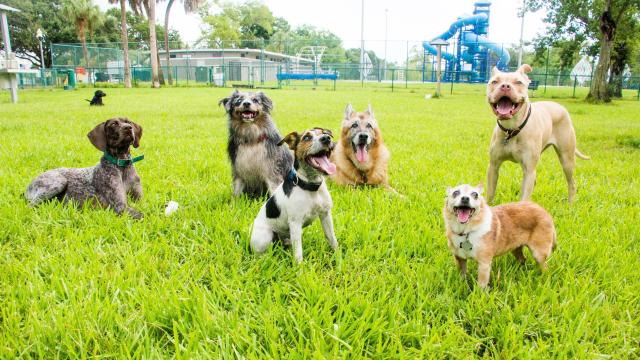The mere name “dog park” suggests a haven for our four-legged friends, but many veterinarians and pet parents argue that dog parks are unsafe. These anti-dog park advocates point to a list of potential issues—anxious dogs, unchecked animal aggression, and disease transmission among them. But while that all sounds bad, the level of risk isn’t all that much different than what you’d face yourself engaging in sports at the park.
Dog parks often represent the only place a city dog can run around off-leash, and they can also play a role in socialising animals with other dogs, as well as other people. While there are risks associated with bringing your pup to one of them, you can mitigate them with these tips.
Don’t bring young puppies or unvaccinated dogs to the dog park
Like humans, puppies should receive a series of vaccinations starting at 6-8 weeks old, with shots spaced out over their first months of life to help build their immunity. While some dogs need additional boosters up until their 20th week, guidance suggests that your dog needs to be at least 17 weeks old before having enough immunity to safely visit the dog park.
That said, not all dogs are vaccinated, and the dog park isn’t an appropriate place for unvaccinated dogs. First, vaccinations are required for a dog to be licensed, and in most communities, all dogs are required to be licensed, so having an unvaccinated dog out and about may violate local laws. Second, the dog park is by nature a breeding ground for canine diseases, and vaccination is a key way to stop the spread to your dog and from your dog. Moreover, vaccinations and preventative treatments can only curb some of the diseases you’ll run into at a dog park, like parvovirus, kennel cough, and worms, so it’s vital to protect them as much as possible.
Bring your own water bowl
Lots of dog parks feature communal water bowls or fountains, which sadly are also a good way to spread illnesses like canine flu, internal parasites, Giardia, kennel cough, and salmonella. The easiest way to prevent this is to ensure your pup is up to date on vaccines and all parasitic preventatives (see above) and to bring your own water bowl. The water source isn’t usually a problem, so you likely don’t need to bring your own water—just ensure your dog has access to their own bowl (like this easy-to-clean collapsible bowl), and that they don’t partake in the communal bowl.
And if your dog is experiencing diarrhea, weight loss, vomiting, dehydration, failure to gain weight, and lethargy, you should see your vet for treatment.
Always keep your dog in sight (and practice voice recall)
As in any public venue, you can’t control what will happen or who will be at the dog park. Your experience will be unpredictable for the simple fact that dogs (and people) can be unpredictable. The best way to ensure your animal’s safety is to make sure you’re engaged in what they are doing, so keep your canine within eyesight at all times, and train your dog to respond to voice recall—basically, that’s when you say, “Come!” and they listen to you no matter what.
This will allow you to pull your dog away from a situation where they might be unsafe or are getting too excited. Practice recall at various times while you’re in the park, so they won’t simply associate the command with the end of playtime.
Clean your dog’s feet after visiting the dog park
Not to speak the obvious, but the dog park is full of dog poop. While hopefully, owners are good about picking up after their pets, the dirt is not exactly scrubbed of bacteria when someone picks up after their dog. And dog poop can have worms in it if the dog is infected. (A DogPARCS study found worms or intestinal parasites in 85 per cent of parks studied.)
As your dog walks through the park, they can pick poop up on their paws, just as you can get it on your shoes. Dogs that roll around on the grass or eat whatever they come across have a higher risk of becoming infected. So when you get home, wipe your dog’s paws off well, or bathe them if they’ve been rolling around, to ensure that you’ve removed the poop. Also, clean the bottom of your own shoes or take them off outside.
Working with your vet to keep your dog on a deworming regimen is also key to ensuring they don’t bring home worms from the park. Parasites can be expensive to treat, and can also cause great discomfort to your dog.

Leave a Reply
You must be logged in to post a comment.